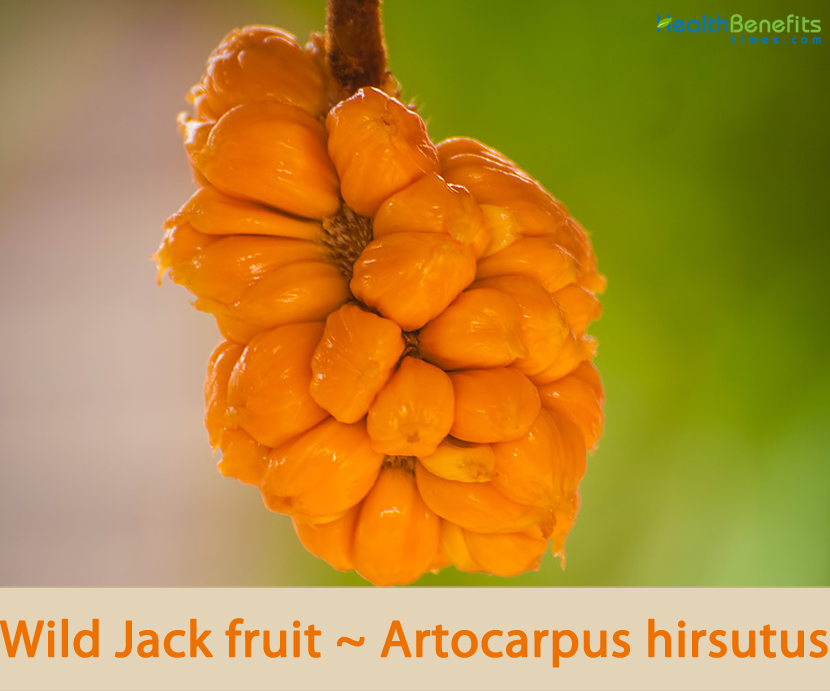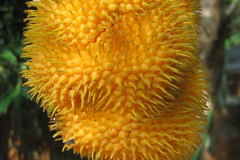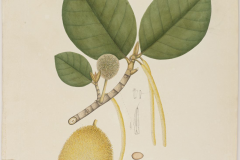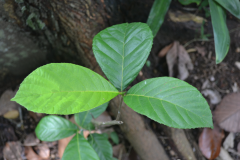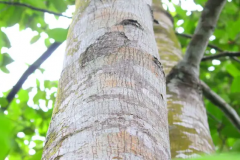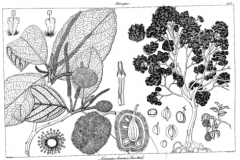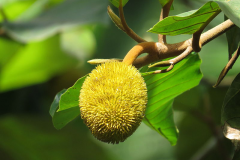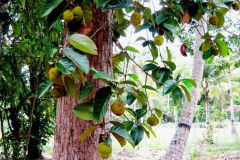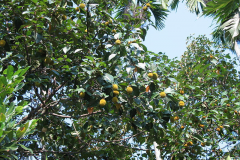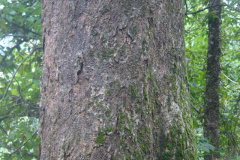| Wild Jack fruit Quick Facts | |
|---|---|
| Name: | Wild Jack fruit |
| Scientific Name: | Artocarpus hirsutus |
| Origin | India, primarily in Kerala, but also in Karnataka, Maharashtra and Tamil Nadu |
| Colors | Initially green turning to yellow to orange when ripe |
| Shapes | Syncarpous fruit about 5 cm long and 4 cm in diameter. They are short cylindrical and ellipsoid. |
| Flesh colors | Yellowish |
| Taste | Sweet |
| Health benefits | Increases blood LDL levels, Antioxidant enriched, Reduces risks of heart diseases, Anti-inflammatory properties |
| Name | Wild Jack fruit |
|---|---|
| Scientific Name | Artocarpus hirsutus |
| Native | India, primarily in Kerala, but also in Karnataka, Maharashtra and Tamil Nadu. It is endemic to the Malabar, south and central parts of Western ghats and Maharashtra Sahyadris |
| Common Names | Wild Jack, Aiyinipila, Aini-maram, Aani, Anhili, Anjili, Hebbalasu |
| Name in Other Languages | Chinese: Cónglín bōluómì (叢林波羅蜜) English: Coffee-shade tree, Kerala boat-builders’ tree, Wild jack-fruit tree, Hirsute artocarpus, Wild Jack Fruit, Wild Jack, Aiyinipila, Aini-maram, Aani, Anhili, Anjili, Hebbalasu French: Jacquier de l’Inde, Jacquier hirsute Hindi: Vadahar Indonesian: Anjili Kannada: Hebbalasu, Hebbhalasu, Hebhalasu, Ārṭōkārpas hirsuṭa (ಆರ್ಟೋಕಾರ್ಪಸ್ ಹಿರ್ಸುಟ), Kadu Halasu, Hebbalasu (ಹೆಬ್ಬಲಸು), Kabbalasu (ಕಬ್ಬಲಸು), Kaadu halasu (ಕಾಡುಹಲಸು), Hesva (ಹೆಸ್ವ), Hesava (ಹೆಸವ) Konkani: Ranpanas, Pachpanas Malayalam: Anjili (ആഞ്ഞില്), Anjili chakka (ആഞ്ഞില് ചക്ക), Ayani (അയണി), Ayani chakka (അയണി ചക്ക), Ayini plavu, Anniliayari, āññili (ആഞ്ഞിലി) Marathi: Pat-phanas, Pat-phunas, Bakodyo Sanskrit: Lakuch (लकुच), Panasah, Lakucah, Panasa Tamil: Anjili (அஞ்ஜிலி), Aiyinipila (ஆய்னிபிலா), Pala, Palavu, Aiyini pala, Kattuppala, Kurangu pala, Pei pala, Ayaṉi (அயனி), Anilī (அநிலீ) Telugu: Pejata, Adavi panasa Tulu: Perpela, Pejakai Unidentified: Aangili, Aanjili, Aini, Aini maram, Anjali |
| Plant Growth Habit | Large tropical evergreen tree |
| Growing Climates | Semi-evergreen, moist deciduous forests, moist, deciduous to partially evergreen woodlands |
| Plant Size | Grows up to a height of 35-45m and a girth of about 5m or more |
| Bark | Bark dark grey, smooth when young, later scaly/flaky, lenticellate; blaze cream |
| Leaf | Simple, alternate, spiral, clustered at twigs end, broadly egg shaped or elliptic. Stipules are 2.5 cm long, lanceolate, with scattered hairs above and dense hair below leaving annular scar. Petiole is nearly 3 cm long, stout, sub-terete or Plano convex. Lamina is 10-30.5 cm long and 5-14 cm broad, ovate to broadly elliptic |
| Flowering season | December to January |
| Flower | Separate male and female flowers with numerous, minute, greenish yellow and can be separately seen in different heads of same plant in the leaf axils. Male heads are cylindrical, about 15 cm long and 1cm wide, pendulous with age of about 3 cm long hairy peduncles. Female heads are ovoid about 3 cm long and 1.5 cm wide |
| Fruit Shape & Size | Syncarpous fruit about 5 cm long and 4 cm in diameter. They are short cylindrical and ellipsoid |
| Fruit Color | Initially green turning to yellow to orange when ripe |
| Seed | Seeds 16-18 mm long, ovoid, white |
| Taste | Sweet |
| Plant Parts Used | Bark, Dried Leaves, Leaves, Fruits |
| Propagation | By the seeds, cutting and air layers |
| Season | May and June |
| Health Benefits |
|
| Precautions |
|
Plant Description
Wild Jack fruit or Wild Jack is a large tropical evergreen tree that normally grows up to a height of 35-45 m and a girth of about 5 m or more. The plant is found growing in semi-evergreen, moist deciduous forests and also partially evergreen woodlands. It is found at an altitude of up to 1300 m in the lush evergreen forest area of peninsular India. The tree prefers a moist atmosphere where rainfall is about 1500mm annually and thrives in deciduous to partially evergreen woodlands. It is easily distinguished from the common jack fruit – Artocarpus heterophyllus, by the smaller sized edible fruits.
Bark
The bark is 10-15 mm thick, surface dull grey-brown, smooth, warty exfoliations thin, peeled surface red, fibrous; blaze creamy turning to pinkish-yellow; exudation milky white, sticky. The branches of the tree are strigose with tawny hair and annular scars. The exudates called as latex will be milky white, sticky and profuse.
Leaves
Leaves are simple, alternate, spiral, clustered at twigs end, broadly egg shaped or elliptic. Stipules are 2.5 cm long, lanceolate, with scattered hairs above and dense hair below leaving annular scar. Petiole is nearly 3 cm long, stout, sub-terete or Plano convex. Lamina is 10-30.5 cm long and 5-14 cm broad, ovate to broadly elliptic. When it is young it is densely hirsute beneath. The apex of leaf is sub-acute or shortly acuminate, base is rounded or sub-acute, and margins undulate. Ten to twelve pairs of secondary nerves can be visible.
Flowers
Separate male and female flowers with numerous, minute, greenish yellow and can be separately seen in different heads of same plant in the leaf axils. Male heads are cylindrical, about 15 cm long and 1cm wide, pendulous with age of about 3 cm long hairy peduncles. Female heads are ovoid about 3 cm long and 1.5 cm wide. Flowering normally takes place in between December to January.
Fruits
Fertile flowers are followed by syncarpous fruit about 5 cm long and 4 cm in diameter. They are short cylindrical and ellipsoid. Fruits are initially green turning to yellow to orange when ripe. It is covered with numerous spines like projections. Seeds are long, ovoid, white, 1.3-2cm long. The seeds are also edible, usually fried as a snack.
The structure is similar to that of the much larger jackfruit. Outer look of the fruit is subglobose or ellipsoid with long echinate and yellowish green or yellow color. The inner edible part is smaller, thinner and about the size of a lemon, orange hued when ripe and ovoid. Mode of propagation is by the seeds, cutting and air layers.
Medicinal uses of wild jack tree
| Plant Parts | Indication |
| Bark (ash)
|
Mixed with coconut oil is used externally against ‘dhobi’s itch’ and ringworm |
|
Bark (paste) |
In coconut oil also can apply for snake bite |
| Domestic animal bone fractures: mixed with palm sugar made into a thick paste on fracture | |
| Leaves (dried) | Joint pain and rigidity |
|
Leaves |
Crushed with turmeric can treat chronic hemorrhage with continuous application. |
| Used as part of a camphorated poultice for the treatment of swelling of testicles originating from contusion. (A folk medicine in northern Kerala) | |
|
Seeds |
Roasted with crushed onion fried in yogurt and inserted rectally to treat constipation |
| Laxative | |
| Seed Oil | Appetite stimulant |
| Wood | Used as a substitute for wood of Strychnos nux-vomica L. for making ‘oil massage cot’ popularly known as ennathoni (wooden vessel for Ayurvedic oil massage) for the ‘panchakrma’ treatment |
Health benefits of Wild Jackfruit
Wild Jackfruit is the largest known edible fruit in this world. These sweet fruits are enriched with proteins, carbohydrates, vitamins, phytochemicals, and minerals. Both the flesh and seeds can be consumed. After ripening, the fleshy material can be consumed as a raw version. Wild Jackfruit can be consumed as jellies, jam, and ice cream also. The health benefits of wild Jackfruit are mentioned below.
1. Increases blood LDL levels
Lipoproteins of low density are good for human health. Sufficient levels of LDL are required to prevent heart-related issues. They also interfere with DNA damage, protein oxidation, and free radical accumulation pathways. Thus, the consumption of wild Jackfruit is beneficial for your health.
2. Antioxidant enriched
Antioxidants can delay or prevent the oxidation process inside the body. They protect the human body and essential biomolecules from oxidative damage. Free radicals are extremely bad for your health. If there is an excess accumulation of free radicals, the human body is supposed to show symptoms of various diseases. Wild Jackfruit is enriched with a vast range of phytochemicals like carotenoid, an effective antioxidant. The fresh flesh and seed possess ascorbic acid, and phenolic compounds, which help in antioxidant activity. These phytochemicals reduce the risks of high blood pressure, strokes, heart diseases, bone loss, and so on. They can also improve nerve and muscle function. They are also capable of reducing harmful homocysteine concentration in the blood.
3. Reduces risks of heart diseases
Due to high levels of potassium, wild Jackfruit helps in reducing blood pressure. This prevents the risks of strokes and heart diseases. Some other essential minerals obtained from wild jackfruit also contribute greatly to improving heart health.
4. Anti-inflammatory properties
Wild Jackfruit possesses some bioactive components with anti-inflammatory effects. Flavonoids obtained from wild Jackfruit usually inhibit the secretion of inflammatory mediators from the macrophages, neutrophils, and mast cells.
Traditional uses and benefits of Wild Jack fruit
- Its bark cures diabetes, tapeworm infection, anemia, malarial fever, asthma, dermatitis, diarrhea, pimples and ulcers.
- In Chinese medicine, it is used as a remedy for many kinds of diseases.
- This deciduous tree is used in folk medicines and also reported to have antipyretic, antibacterial, antiviral, antifungal, anti-arthritic activity.
- Consumption of wild Jackfruit may prevent cancer cell formation.
- They can be beneficial against stomach ulcers too.
- Niacin obtained from wild Jackfruit contributes to nerve function, and energy metabolism.
- Wild Jackfruit provides large dietary fiber content and helps improve bowel movement.
- Fresh flesh of wild Jackfruit also provides a cooling effect to your body.
- Fruits are usually used as an appetizer and ingredient in snacks.
- Powdered bark is used in healing sores.
- Dry leaves are useful in treatment of bubose and hydrocele.
- Roasted seeds are powdered and mixed with honey for the treatment of asthma.
- An infusion of the bark is applied over the skin to cure pimples and cracks.
- In Ayurvedic medicine, the wild jack plant soothes vitiated vata and pitta, anorexia, burning sensation and sexual weakness.
- Bark has the properties to cure ulcers, diarrhea and pimples.
- Unripe fruits have qualities like aphrodisiac, sweet, astringent, thermo-genic, sour, indigestible, and constipating and can cause flatulence.
- Leaves, fruit and bark are used medicinally; they treat skin diseases and hemorrhage.
- An infusion of bark of Wild Jack is used topically to cure skin problems like pimples and cracks.
- The powdered bark is used to heal sores.
- Dried leaves are used to treat Hydrocele.
- Roasted seed powder is used for the treatment of skin diseases.
- Leaves are used to treat joint pains.
- Leaves are crushed with turmeric to treat chronic hemorrhage.
- Ash of the plant bark mixed with coconut oil is used against ‘dhobi’s itch’ and ringworm externally.
- Bark paste mixed in coconut oil can also applied for snake bite.
- Leaves are used to treat joint pain and rigidity.
- Roasted with crushed onion fried in yogurt and inserted rectally to treat constipation.
- Wood is used as a substitute for making ‘oil massage cot’ popularly known as ennathoni the ‘panchakarma’ treatment.
- Bark infusion is applied to cure small pimples and cracks of the skin.
Culinary Uses
- They are stored in jars adding salt after removing the outer skin. They are used in preparing chutney.
- Fleshy pulp is used for papad making.
- Roasted, dehusked and salted seeds are usually fried and eaten as snack.
- Flour of sun-dried seeds is occasionally mixed with rice flour in the preparation of idli and dosa.
- Seed flour could be added to sambhar and chutney.
Other Facts
- The tree is grown to provide shade in coffee plantations and also as undergrowth in teak plantations.
- The concentrated juice forms a waxy, tough, light brown substance, which when melted, is used as a cement to join broken earthenware and stoned ware.
- The wood is moderately hard, durable; it lasts well in water and is not attacked by white ants.
- Valuable timber is harvested usually for the house construction, boat building, furniture making, etc.
- In the Malabar Coast, it is used to build house boats and racing boats.
- Leaves are useful fodder for elephants.
- Artocarpus hirsutus wood is still widely used for making frames of doors and windows.
- Leaves were widely used on the Malabar Coast for making green manure and compost, especially in paddy cultivation.
- The leaves are rarely used as fodder for cattle or goats in interior villages.
- At higher altitudes in Kerala the trees are used as support for pepper vines.
References:
https://www.itis.gov/servlet/SingleRpt/SingleRpt?search_topic=TSN&search_value=506553#null
https://gd.eppo.int/taxon/ABFHI
https://indiabiodiversity.org/species/show/8066
http://www.theplantlist.org/tpl1.1/record/kew-2653984
https://www.flowersofindia.net/catalog/slides/Wild%20Jackfruit.html
http://www.biotik.org/india/species/a/artohirs/artohirs_en.html
https://en.wikipedia.org/wiki/Artocarpus_hirsutus
http://www.worldfloraonline.org/taxon/wfo-0000550493
https://tropical.theferns.info/viewtropical.php?id=Artocarpus+hirsutus
https://www.cabi.org/isc/datasheet/1833
https://plants.usda.gov/home/plantProfile?symbol=ARHI7


